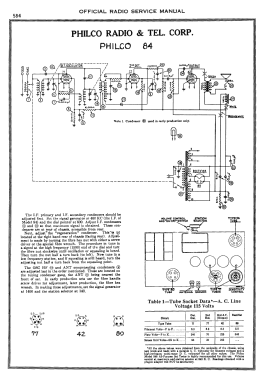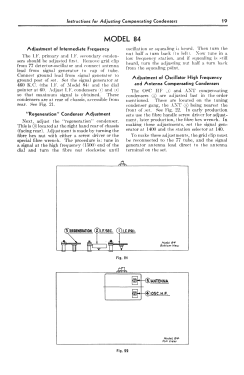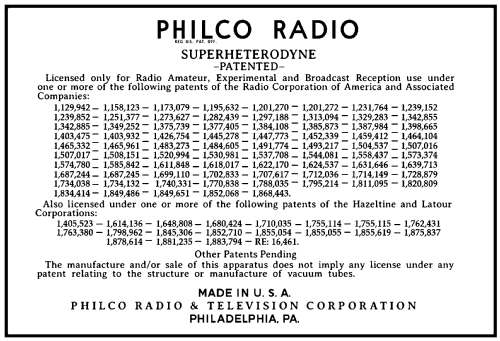84B Middle
Philco, Philadelphia Stg. Batt. Co.; USA
- País
- Estados Unidos
- Fabricante / Marca
- Philco, Philadelphia Stg. Batt. Co.; USA
- Año
- 1935
- Categoría
- Radio - o Sintonizador pasado WW2
- Radiomuseum.org ID
- 139539
Haga clic en la miniatura esquemática para solicitarlo como documento gratuito.
- Numero de valvulas
- 4
- Principio principal
- Superheterodino en general; ZF/IF 460 kHz
- Gama de ondas
- OM (onda media) solamente
- Tensión de funcionamiento
- Red: Corriente alterna (CA, Inglés = AC) / 115 Volt
- Altavoz
- Altavoz electrodinámico (bobina de campo)
- Material
- Madera
- de Radiomuseum.org
- Modelo: 84B [Middle] - Philco, Philadelphia Stg. Batt
- Forma
- Sobremesa tipo Capilla (upright, round top or pinted arch, not rounded edges only).
- Ancho, altura, profundidad
- 305 x 360 x 200 mm / 12 x 14.2 x 7.9 inch
- Anotaciones
- Model 84B was the third of a series (models 80B, 81B, and 84B) of low cost 4-tube cathedrals that used a regenerative combined IF/detector stage to maximize sensitivity with very few components.
The early version (1934) had a round speaker opening with three vertical bars. The middle version (1935) had a lyre-shaped opening with three vertical bars. The late version (1936) had a continuous arch-shape extending upward from the base, and an oval speaker opening with five mostly vertical bars.
Model 84B continued onward for one more year as model 37-84B, with two more cabinet styles, and a new tube lineup (but still using a similar circuit).
- Precio durante el primer año
- 20.00 $
- Procedencia de los datos
- Philco Radio 1928-1942
- Referencia esquema
- Rider's Perpetual, Volume 4 = ca. 1934 and before
- Documentación / Esquemas (1)
- Philco 1928-36 Wiring Diagrams, Parts Lists, and Essential Service Data
- Documentación / Esquemas (2)
- Cathedral & Tombstone Radios (page 194.)
- Autor
- Modelo creado por Thomas Albrecht. Ver en "Modificar Ficha" los participantes posteriores.
- Otros modelos
-
Donde encontrará 4120 modelos, 2227 con imágenes y 3768 con esquemas.
Ir al listado general de Philco, Philadelphia Stg. Batt. Co.; USA
Colecciones
El modelo 84B es parte de las colecciones de los siguientes miembros.
Contribuciones en el Foro acerca de este modelo: Philco, Philadelphia: 84B
Hilos: 1 | Mensajes: 8
Salve ai soci , sono alle prese con un problema di Ronzio su questo ricevitore . nonostante abbia gia sostituito gli elettrolitici il ronzio resta. Ho notato che mettendo a massa la griglia della finale ( 42 ) il ronzio smette , quindi presumo che il difetto sia da reputarsi nella zona finale audio. Un'altra cosa che mi sembra anomala e'la tensione troppo bassa sull'anodica e sulla griglia schermo della 77 nella sezione MF ovvero 50sull'anodica e 35 sullo schermo , nn so anche questo possa portare il ronzio ho sostituito i vari componenti in quella zona ma nulla e' cambiato , se qualcuno puo indicarmi come provare a risolvere il problema le sarei grato . Distinti saluti
GABRIELE,
Gabriele Seccia, 08.Dec.11











































